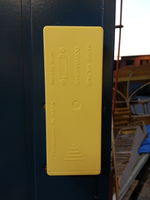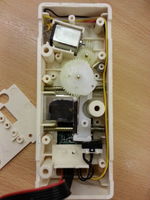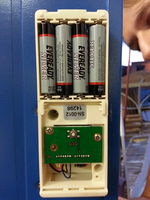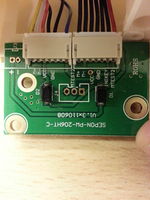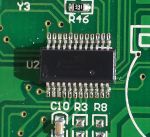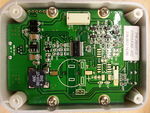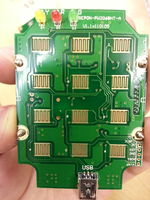Difference between revisions of "Olympic lockers"
(category update) |
|||
| (5 intermediate revisions by 3 users not shown) | |||
| Line 21: | Line 21: | ||
== Mode of operation == | == Mode of operation == | ||
| + | |||
| + | [[File:Olympic-lockers-manual.pdf]] | ||
# Key in a code, hit hash. It locks shut (you can do this before you shut the door, as the bolt is sprung and it will latch). | # Key in a code, hit hash. It locks shut (you can do this before you shut the door, as the bolt is sprung and it will latch). | ||
| Line 41: | Line 43: | ||
QA sticker is damaged. | QA sticker is damaged. | ||
| − | [[Media:200820095244-电子柜锁.pdf|Patent]] belongs to [http://szcolo.en.alibaba.com/company_profile/certificates.html Shenzhen ZFD Industry Co., Ltd.] | + | [[Media:200820095244-电子柜锁.pdf|Patent]] ([http://www.google.com/patents/CN201217999Y?cl=en english translation]) belongs to [http://szcolo.en.alibaba.com/company_profile/certificates.html Shenzhen ZFD Industry Co., Ltd.] |
[[File:20130709_213452.jpg|150px]] | [[File:20130709_213452.jpg|150px]] | ||
| Line 72: | Line 74: | ||
== Keypad board == | == Keypad board == | ||
| − | Chip is painted, but | + | Chip is painted, but is still visibly a [[Media:HT66F40-Holtek_Semiconductor.pdf|Holtek HT66F40]]: |
| + | |||
| + | [[File:P3250010_(cropped).jpg|150px]] | ||
| + | |||
| + | Board has sticker on: | ||
PW-206BHT-O | PW-206BHT-O | ||
| Line 99: | Line 105: | ||
[[File:20130709_221950.jpg|150px]] | [[File:20130709_221950.jpg|150px]] | ||
[[File:20130709_222309.jpg|150px]] | [[File:20130709_222309.jpg|150px]] | ||
| − | |||
== To do == | == To do == | ||
| Line 110: | Line 115: | ||
[[Category:Projects]] | [[Category:Projects]] | ||
| − | |||
[[Category:Space_Infrastructure_Projects]] | [[Category:Space_Infrastructure_Projects]] | ||
| + | [[Category:Outdated Pages]] | ||
Latest revision as of 19:20, 21 October 2021
| Type | Infrastructure |
|---|---|
| Status | Proposed |
| Origin | Project |
| Location | In the space |
| Maintainers | JasperWallace |
We got some lockers from ebay: http://www.ebay.co.uk/itm/2-Door-Metal-Staff-Electronic-Keypad-Locker-Blue-and-Grey-Finish-/121122632797
They use cheap Chinese electronic locks, which we'd like to automate.
The locks take 4xAAA batteries, and have a reset push button of some sort under the battery cover on the inside.
There is a USB mini-B connector on the bottom of the keypad, externally.
There are three LEDs on the outside: amber (code failed), red (battery low), and green (opening).
Some of the locks are glued to the doors.
Mode of operation
File:Olympic-lockers-manual.pdf
- Key in a code, hit hash. It locks shut (you can do this before you shut the door, as the bolt is sprung and it will latch).
- Key in the same code, hit hash. It opens.
Notes
- The bolt is sprung, and will return to whichever position it's set in regardless of power state.
- The lock's "locked" state is based on the position of the bolt, which you can push in. So if you've forgotten the code, and the door is open, you can just hold the bolt into the open position and it'll accept a new code (as in step 1). It'll remain in the shut state until you enter the code again.
- Codes seem to be remembered across battery removal, at least in the short term.
- There appears to be some kind of internal power source, as after the batteries are removed, holding the "reset" button will illuminate the red light for a few seconds. Then (I think) the code is forgotten (although the lock is still not open!).
- Presumably there is a master code for letting you unlock a forgotten code, or else the USB connector has something to do with it. However, the USB connector does not appear to present a USB device.
- The USB connector can be used to power the lock in the case of a battery failure, however with a fairly modern Macbook Pro as a power source this was very intermittent (how intermittent seems to vary between locks). Repeatedly cycling the USB power until pressing a key made a beeping sound meant that the lock could be used as normal, powered via USB.
- My suspicion is that the USB connector is intended to be used with a dumb USB charger-style device rather than a computer.
Casing
MODEL: SN-DJ500 PATENT NO.:200820095244.2
QA sticker is damaged.
Patent (english translation) belongs to Shenzhen ZFD Industry Co., Ltd.
Motor board
Silkscreen says "SEPON-PW-206HT-C V1.3x110608". Jumpers for power and motor testing.
Motor connector:
- M+ (yellow)
- M- (white)
- VCC (red)
- GND (black)
- MTEST2 (blue)
Keypad connector:
- M+
- M-
- GND
- VCC
- INIKEY?
- MTEST2
Keypad board
Chip is painted, but is still visibly a Holtek HT66F40:
Board has sticker on:
PW-206BHT-O C316&A260_v102 P/N:0012 14298
Silkscreen says "SEPON-PW206BHT-A V1.1x110105"
There's a header on the left (from chip side) labelled JISP, with pins:
- 3V
- RST
- GNS
- ISCK
- DATA
and in the middle at the bottom, a USB breakout:
- GND
- D+
- VCC
- ИC (sic)
- D-
P/N is reprinted variously around the board as S/N.
To do
Take a keypad apartWork out how to run power to a locker- has a + and - solder pads we can use
Work out how to lock and unlock a locker- the motor needs to be run in both directions, there is a micro switch that is engaged (or disengaged) when the lock is open.
- Wire up and arduino (or something) all of them.
